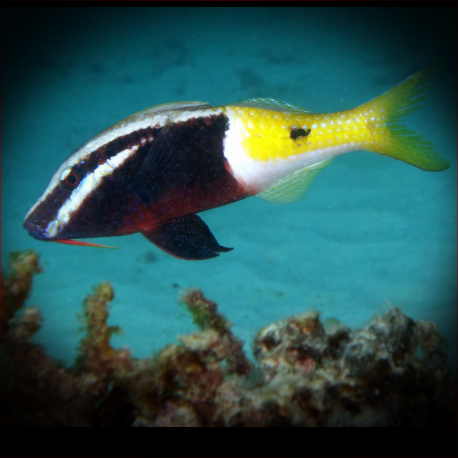More info
Datasheet
| Minimum Tank Size | 700 litres / 184.92 US gallons |
| Maximum Size | 30.0cm / 11.81inches |
| Reef Compatible | Reef safe with caution |
| Temperament | Docile |
| Temperature | 22.2°C / 71.96°F - 25.6°C / 78.08°F |
| Specific Gravity | 1.020-1.025 |
| Carbonate Hardness | 8-12 |
| pH | 8.1-8.4 |
General Description: The Bicolor goatfish, scientifically known as Parupeneus barberinoides, belongs to the Mullidae family and is identifiable by its distinctive "beard" used for foraging in sand. This species grows up to 30.0cm in length and is native to the Western Pacific region, ranging from the Moluccas and Philippines to western Samoa. It can also be found as far north as the Ryukyu Islands and as far south as New Caledonia and Tonga.
Aquarium Suitability: Classified as requiring experience, preparation, and extra care, the Bicolor goatfish is not particularly well-suited for aquarium life due to challenges with sustaining their dietary needs. They are known to be predators, posing a threat to small fishes and crustaceans in the tank. These fish demand a tank size of at least 700 liters and a varied diet fed 4-5 times a day to thrive in captivity.
Care and Hardiness: With an average hardiness level, this species is docile and shy, necessitating caution when housed with more aggressive tank mates. They have specific dietary requirements that are essential to their survival, and they thrive in environments with ample swimming space due to their active nature.
Reef Suitability: Considered reef-safe with caution, the Bicolor goatfish may pose a threat to small invertebrates within a reef environment. Their foraging behavior in the sand can disrupt the substrate and potentially affect the delicate balance of a reef tank.
Aquarium Setup: To accommodate the Bicolor goatfish, an aquarium should have a large open area with a mix of sand and coral gravel to mimic their natural habitat. Providing numerous feeding opportunities is crucial, as they tend to deplete natural food sources quickly within the tank.
Behaviour: Known to be docile yet active swimmers, these fish exhibit a shy demeanor and require a peaceful tank environment devoid of aggressive companions. Their foraging behavior involves sifting through sand to find food, which can lead to cloudiness in the water.
Feeding and Diet: The recommended diet for the Bicolor goatfish includes fish, larger crustaceans, smaller crustaceans, and zooplankton. Frequent feeding, multiple times a day, is essential for their nutritional well-being, especially when young and still acclimating to aquarium life.
Dimorphism: Information regarding dimorphism and captive reproduction of the Bicolor goatfish is not provided in the available data.
Habitat and Distribution: In the wild, these fish inhabit regions spanning from the East Indian Ocean to the Central/West Pacific, including locations like Japan and Indonesia. Their distribution extends across various island chains in the Pacific, emphasizing their adaptability to diverse marine environments.

